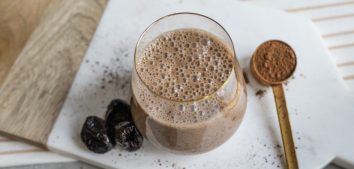
Body Recomposition
I see more and more often that your training goal is a healthy, fit, and strong body, and not a smaller number on the scale. All this can be achieved through regular physical activity based on resistance/strength training. Professionally, the process of changing body composition is called recomposition. If it doesn’t ring a bell, today you’re about to find out what it’s about. Enjoy!
What Is Recomposition?
Let’s start with the basics. Body recomposition, i.e. changing body composition, is a process aimed at reducing fat tissue and increasing muscle mass among people who do strength training.
It is common knowledge that in order to reduce fat tissue, it is necessary to introduce an energy deficit. This means that you need to eat less than your body expends. However, in order to build muscle mass, a calorie surplus is usually necessary with an adequate supply of protein and a stimulus in the form of strength training.
Therefore, people who work out very often introduce alternating periods of reducing and building muscle mass. Is this the optimal way to achieve an athletic body? Is it possible for both of the above-mentioned processes to occur simultaneously?
What Do the Researchers Say?
More and more researchers are exploring this topic. The studies involve both recreational exercisers and professional athletes.
Research studies show that recomposition is by all means possible. The greatest positive changes are observed in people with less training experience, but the important fact is that body recomposition can be carried out regardless of age, gender or training experience. It’s just that the scale of change will vary.
The Constituents of Correct Recomposition
Nutrition
You should ensure an increased share of protein in your daily diet. Research shows that the effects are brought by a protein supply equal to or higher than 2g/kg body weight. For optimal effect, protein should be distributed evenly over meals throughout the day, so that each meal contains at least 20g of protein.
Energy demand depends on the initial body weight and fat tissue content. If the body weight is normal and the level of adipose tissue is at the lower limit of the norm (in men this norm is about 12-14%, while in women: 22-24%), then you can follow a normocaloric diet or with a slightly positive energy balance that amounts to about 200 kcal per day. However, if the level of body fat is higher to start with, the caloric content of the diet should be reduced by about 5-10% of the daily requirement. Which is often about 200-300 kcal less.
Strength Training
It’s a must. If we want to build muscle mass and strength, and improve our appearance, resistance training is essential! Setting goals and priorities is key. Then you need consistency and weight progression, and success is guaranteed! A study from 2020 indicated that to achieve the intended recomposition goal, you should perform a minimum of 3 training units a week. My application was created to help you in the training process, you can find more information on which training program to choose HERE and HERE.
Regeneration, or the Right Amount of Hours and Sleep Time
What I mean here are the breaks between training sessions, which ensure the regeneration of the trained muscle groups, and thus enable their growth. The time of breaks between training sessions is one of the factors that should be planned when building a training plan. When we talk about sleep, it is not only about the number of hours of sleep, but also about its quality. I encourage you to read valuable information on this subject HERE.
Patience
Recomposition is a process that takes time and consistency. The results are often more visible in the body measurements, in the mirror, than on the scale itself. I think that every person who has undergone this process will admit that it was worth it!
Recomposition and Individual Predispositions
I have already mentioned that recomposition is possible for everyone. However, it is important to be aware of your limitations, as well as your training and nutritional options. The main determinant of how often we can do sports and how much time we have to prepare meals is our working style and the number of daily responsibilities. That’s why it’s always important to set realistic goals!
For recomposition to take place, strength training must be combined with an appropriate diet. You can’t skip any step here. Therefore, it is worth planning this time well. It always helps me to plan and write down my training sessions in my calendar. My application works great HERE, thanks to which you can plan your training on specific days and set a training reminder. You will do this when choosing the program. Then you select on what days you want to work out and it automatically synchronizes with the application calendar. Moreover, in SETTINGS and REMINDERS about the training – you can set a specific time at which it should appear.
What’s more, I do my shopping once in several days or use catering services. Thanks to these treatments, I don’t have to worry about suddenly running out of time for training or not eating the right amount of protein during the day.
Summary
I think it is clear enough by now: recomposition is a process that requires a combination of a nutrition and training plan tailored to the current body composition, with a planned progression of load. I hope that the information above will help you achieve your goals and enjoy a strong, athletic body 🙂
Bibliography
- B. I. Campbell et al., “Effects of High Versus Low Protein Intake on Body Composition and Maximal Strength in Aspiring Female Physique Athletes Engaging in an 8-Week Resistance Training Program,” Int J Sport Nutr Exerc Metab, vol. 28, no. 6, pp. 580–585, Nov. 2018,
- F. B. Del Vecchio, “Body Recomposition: would it be possible to induce fat loss and muscle hypertrophy at the same time?,” Revista Brasileira de Cineantropometria & Desempenho Humano, vol. 24, p. e86265, Sep. 2022,
- J. Antonio et al., “A high protein diet (3.4 g/kg/d) combined with a heavy resistance training program improves body composition in healthy trained men and women – a follow-up investigation,” J Int Soc Sports Nutr, vol. 12, no. 1, pp. 1–9, Oct. 2015,
- M. T. Stratton et al., “Four Weeks of Time-Restricted Feeding Combined with Resistance Training Does Not Differentially Influence Measures of Body Composition, Muscle Performance, Resting Energy Expenditure, and Blood Biomarkers,” Nutrients 2020, Vol. 12, Page 1126, vol. 12, no. 4, p. 1126, Apr. 2020
- T. M. Longland, S. Y. Oikawa, C. J Mitchell, M. C Devries, S.t M Phillips. Higher compared with lower dietary protein during an energy deficit combined with intense exercise promotes greater lean mass gain and fat mass loss: a randomized trial. Randomized Controlled Trial Am J Clin Nutr; 103(3):738-46. Mar. 2016.











Comments No Comments
Join the discussion…